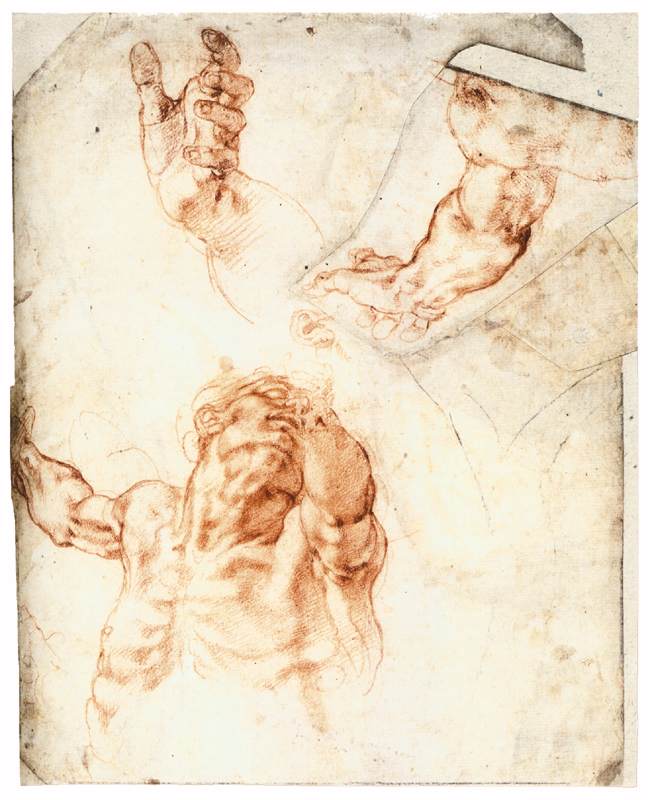
Michelangelo Buonarotti (1475-1564) was a famous Italian artist of the Renaissance period. His drawing Five Studies for the Figure of Haman represents one of the scenes of the Cappella Sistina (the Sistine Chapel), the crucifixion of the Jews’ enemy Haman (fig. 1). In the artist’s practice, drawings often preceded paintings because they helped him create the works of art faster and easier. In Five Studies for the Figure of Haman, the painter uses red and black chalk, three-dimensional structure, and anatomical images as parts of his critical thinking process that help him paint the Sistine Chapel’s ceiling.
Michelangelo emphasized the importance of drawings because they were an essential part of the painting process. He often said that he “was never a painter or sculptor like those who make a business of it” (Sebregondi 9). This statement demonstrates his caring attitude to the process of art in general and drawing in particular. It also shows that he painted sketches and cartoons not to make his larger works better for the public but to prepare all necessary steps for himself. The drawing was as significant as painting and sculpture for Michelangelo; that is why Michelangelo’s sketches are evaluated as art today. The artist’s numerous pictures and cartoons demonstrate his well-developed critical thinking and imagination that helped him paint the greatest Sistine Chapel.
By using red chalk, Michelangelo hoped to accomplish the drawing quickly. For many artists, sketches preceded paintings, sculptures, and works of architecture (Keizer 311). Michelangelo was not an exception, and his drawing The Figure of Haman was a draft of his great frescos for the Sistine Chapel. Red chalk was easy to use, and taking into account the huge amount of preparation for the main work of art, Michelangelo preferred to save time and reduce the work on preliminary sketches. Moreover, red chalk could create subtle and mid-tone variations on the paper. Thus, when the artist needed a darker tone, he could wet red chalk, and the necessary effect would be achieved. This material allowed the artist flexibility because he could take it with him and continue the process of painting anywhere. Therefore, Michelangelo’s critical thinking allowed him to save time and create an effect of lights and shadows, using the only material – red chalk.
The drawing also contains some traces of black chalk at the right part of the sheet. These faint traces “could represent either the tree on which Haman was crucified or the outside of the pendentive’s frescoed frame” (Bambach 661). According to Bambach, the black lines on the image halt suddenly, which means that the drawing was obscure and incomplete (661). On the one hand, Michelangelo might use dark chalk to separate the image of Haman’s hand from his body image. However, taking into account the artist’s critical thinking process, one may assume that the black chalk traces denoted an unfinished drawing. Since the drawing was only a preparation for the main work of art, it could remain uncompleted.
Although the preliminary sketches were a normal part of Michelangelo’s art process, the use of three-dimensional structure demonstrates that this process was essential for him. The drawing depicts Haman’s arm from different perspectives, creating a three-dimensional (3-D) view of this part of the body (fig. 1). In such a way, Michelangelo tried to reinforce the meaning of this image and allude to his fresco “Creation of Adam.” On the fresco, Adam is “about to touch God through the contact of their fingertips,” symbolizing a connection between humans and religion (Ellwanger et al. 38). On the drawing, Haman’s arm is turned to God or the audience in a similar manner, and every fingertip is visible due to its 3-D structure (fig. 1). Michelangelo’s aim was to create a deeper sense of this scene, a sense of remorse and pleading for help, which can be better achieved through the 3-D images of a begging hand.
As many other artists of the Renaissance period, Michelangelo paid close attention to anatomical images in his paintings. He believed that male nudity “was grounded more deeply in time and in design than the dressed male” (Keizer 312). Different researches proved Michelangelo’s knowledge of human anatomy, so his detailed depiction of a human body was not surprising. From this perspective, the artist was obsessed with the human body and tried to paint each of its parts in the most precise manner. On the drawing, for example, one can see every muscle of Haman’s arms and neck and every bone of his chest (fig. 1). To create a realistic effect, Michelangelo utilizes his critical thinking and imagination. He plays with light and shadow masterfully and creates a real-like image of a man. Obviously, the artist would not be able to produce such masterful pieces of art if he did not utilize critical thinking.
Having analyzed Michelangelo’s drawing Five Studies for the Figure of Haman, one can conclude that the artist used it as a part of the critical thinking process over his painting for the Sistine Chapel. For the artist, the drawing was as important as painting and sculpture, so it could not be ignored or avoided. At the same time, Michelangelo used sketches and cartoons as drafts which would never be admired by the public. His drawings would allow him to create great paintings and sculptures easier and faster than if he did not use any sketches at all.
Works Cited
Bambach, Carmen C. “A Note on Michelangelo’s Cartoon for the Sistine Ceiling: Haman.” The Art Bulletin, vol. 65, no. 4, 1983, pp. 661-665. JSTOR, doi:10.2307/3050374.
Ellwanger, Joel Henrique, et al. “Anatomy Lessons in Michelangelo’s Works?” Journal of Morphological Sciences, vol. 29, no. 1, 2012, pp. 38-43.
Keizer, Joost. “Michelangelo, Drawing, and the Subject of Art.” The Art Bulletin, vol. 93, no. 3, 2011, pp. 304-324. JSTOR.
Sebregondi, Giulia Ceriani. “On Architectural Practice and Arithmetic Abilities in Renaissance Italy.” Architectural Histories, vol. 3, no. 1, 2015, pp. 1-15.